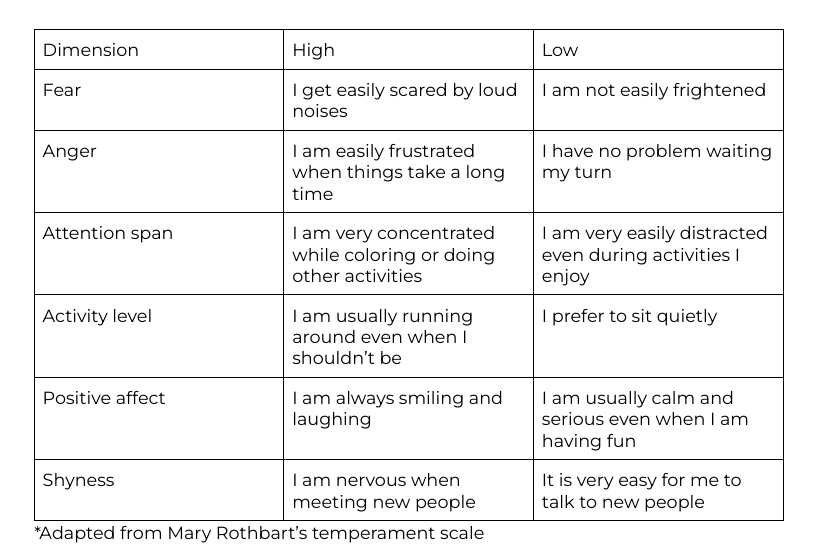How does our temperament shape our emotional responses? Today we’ll explore our emotions in further detail through a fun activity!
Materials
Notecards/paper
Pen or pencil
Optional: markers or colored pencils, printer
Time Estimated:
20 minutes
Directions:
Start by taking a look at these definitions:
Emotion: Feelings caused by situations or people
Temperament: An individual's way of responding to situations and handling emotions
Emotion regulation: The ability to control your emotions
Gather your supplies and brainstorm different emotions to write on the notecards. Feel free to decorate the cards or add drawings! Any number of people can participate at once!
Examples: Happy, Prideful, Excited, Silly, Sad, Angry, Embarrassed, Nervous, Bored
Take a look at this chart and think about which qualities of temperament relate to you the most! If you are able to print the chart you can circle whether you fit into the high or low category for each quality. You can also grab a pencil and paper and write which category you feel relates to you the most. Keep in mind you may feel like you fall into both the high and low categories. This is because our temperament changes based on different situations. Try to think about which one you experience most often.
Temperament and emotion
Lay all of the cards face down. Then, each person takes turns flipping over a card. After you flip it, each person should share how they act or feel when experiencing the emotion on the card. Talk about how each of your reactions are similar or different. What characteristics of your own temperament cause you to react this way? Think about the qualities you associated with your temperament in the first part of the activity.
Responding to emotional situations
Now that you have reflected on your experiences, let's prepare for future emotional situations! Lay the notecards face down and take turns flipping over a card. The person who flips it over should think of a situation which would cause the participants to feel the emotion on the card—take a look at some of the example situations below, or think of your own!
Each participant should share how they would react in this situation, and how their temperament causes these different reactions. Keep in mind the characteristics of your own temperament you talked about in the previous steps. Does your temperament cause you to have stronger emotional reactions? Think about the differences between you and the other participants and how you could respond in these situations to manage your emotions.
Examples: You want to leave class because you are mad. You don’t understand your homework assignment. Your friend broke your favorite toy. You don’t get to sit next to your best friend in class. Someone keeps distracting you in class. You trip and fall in front of your class. You feel sleepy during class. You are going to have a playdate with your friends after school. Your team won in gym class. Your sports team won their game. You earned 100% on a test. You get to have your favorite food for dinner. Your parent surprises you with a trip to Disney World.
Mindfulness
Talking about emotions, especially negative ones, can be tiring! End this activity with a deep breathing exercise to relax. This is also a technique you could use in some of the highly emotional situations you just discussed.
Use your index finger to trace your other hand. Starting with your thumb, breathe in until you get to the tip of your finger. Then breathe out until you reach the bottom of your thumb and index finger. Repeat this tracing your whole hand and until you feel calmer.
Use this resource for help with mindfulness: https://www.wellnesspediatrician.com/3-breathing-exercises-for-toddlers-kids-and-teens/
Think Like a Scientist!
How does your temperament cause you to respond differently than others to emotional situations?
How do your surroundings influence how you react emotionally to certain situations?
Do you think it is important to know about your specific temperament? Why or why not?
How can emotion regulation impact your temperament?
How Does it Work?
The purpose of this activity is to understand your emotions and why some situations cause certain emotions. Your overall reactions and emotional patterns to events in your life shape your temperament. Temperament is your individual way of reacting to situations. Temperament changes across situations and through emotion regulation. Emotion regulation is how you deal with your feelings.
Further Exploration:
Being aware of how you typically respond to different environments can help you regulate your emotions in highly emotional situations. This activity is helpful to recognize your emotional patterns because it makes you think about situations in which you have experienced strong emotions. The goal is to help you plan for future emotional experiences in a healthy way and give you tools to calm those emotions. A great tool to use is mindfulness. When you’re feeling overwhelmed by your emotions, mindfulness allows you to take a time out to reflect on how you’re feeling and calm down.
Anticipated Concerns
Students may struggle to openly share their emotions or connect to the example scenarios provided in the instructions.
Check out more empowering activities here!
Looking for more fun at-home STEM activities for your young scientist? Check out our workbook full of exciting science experiments and empowering activities!
Learn more and purchase today!




